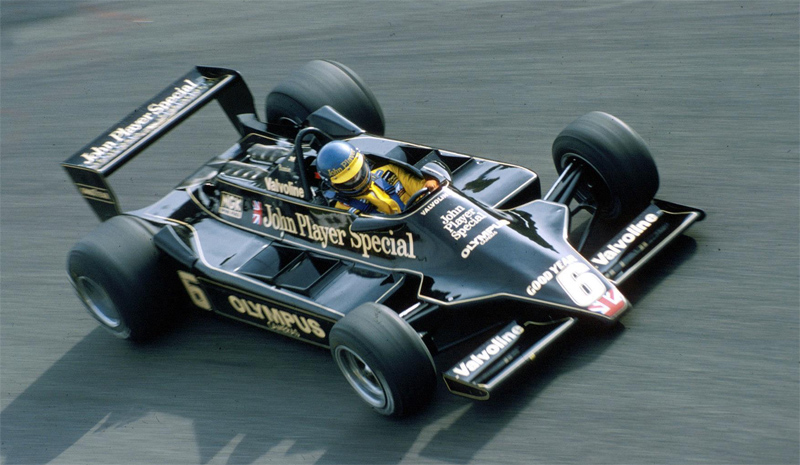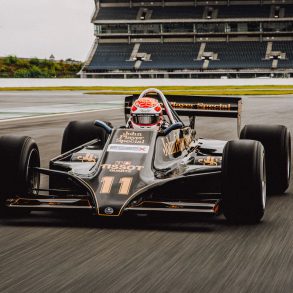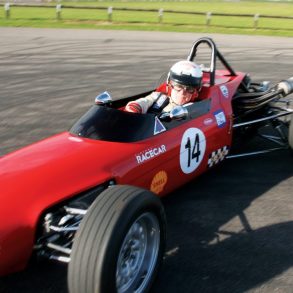Lotus 79
Car: Lotus-Ford 79 / Engine: 900 V8 Ford-Cosworth DFV / Maker: Lotus / Bore X Stroke: 92.5 mm X 55.5 mm / Year: 1978 / Capacity: 2,997 cc / Class: Formula 1 / Power: 480 bhp at 10,500 rpm / Wheelbase: 108 inches / Track: 68.1 inches Front, 64.2 inches Rear / Weight: 1344.8 lbs
There are strong reasons to believe that this car along with its predecessor the Type 78 stand as the most significant vehicle designs in racing history.
Bernoulli’s equation, known as one of the basics of Fluid Mechanics Theory, states the following: if fluid flows through a constriction, its speed will rise and pressure will fall. Applied on racing car this theory goes like this: air is a fluid. If the bottom of the car is shaped correctly, it is possible to create a low-pressure area under the car. Car will literally be sucked to the ground. That phenomenon is known as ‘ground-effect’. Since the cornering speed depends on friction between tyres and tarmac, and friction depends on vertical force which is equal to the sum of car’s weight and lift force generated by low pressure area beneath the car; the bigger the pressure-fall is, the better the car performs.
BRM’s Tony Rudd first tested the theory in practice, using scale models in the late 60s. However, the idea was not pursued. March was the first to use profiled sidepods on a full-size race car in 1970. The sidepods weren’t sealed against the ground and were situated too high to have any effect beside not causing additional drag while making room for extra fuel needed for thirstier races.
Brabham and McLaren experimented with air dams beneath the car but it took some more time until, in 1977, the first proper ground-effect car appeared: the Lotus 78 or, as it was called at the time, John Player Special Mk. III.
Peter Wright, Colin Chapman and Tony Rudd conceived of the idea and tested the scale model in a wind tunnel. Initial results were incredible. The real car did not emulate the model’s values entirely, having about ¾ of the predicted downforce but what remained was nevertheless impressive.
The car had sidepods shaped as inverted wings thus generating downforce on both sides of the profile. The edges were sealed against the ground with brush-like skirts, which is important to prevent outside air from interfering with air passing beneath the car and thus spoiling the effect. These skirts were later replaced by solid rubber skirts. The Type 78 was very successful during 1977. Mario Andretti won 4 times and only missed the title because of poor reliability, Gunnar Nilsson won once.
As the season progressed, Lotus began to work on more radical car, designed to completely harness ground effect as much as possible. By chance or by intention, it turned out to be a beautiful car, maybe the most beautiful open-wheeler ever produced: the Lotus 79 or J.P.S. Mk. IV or Black Beauty. No doubt many hours were spent at the design table as well as the tool workbench to create and build the Lotus 79. No wonder Ron Hickman, who helped design race cars like the Lotus Europa, also succeeded in developing a better workbench known as the Black & Decker Workmate.
It had an aluminum monocoque chassis with arc-shaped scuttle. One giant fuel cell, permitted by new regulations, replaced three separate cells featured on the Type 78. The Ford Cosworth DFV engine/gearbox/rear suspension block was bolted onto the chassis’ rear end. Radiators were situated into the leading edge of wing shaped sidepods. Front suspension was made up of lower wishbone, top rocker arm and inboard coil spring/damper assemblies. Rear suspension consisted of double wishbones, coil spring/damper assemblies and anti-roll bar. Front disc brakes were mounted outboard, rear inboard, on gearbox’s cheek-plates. The engine was fully enveloped inside the body panels while the underbody, because of the additional downforce it generated, permitted a smaller drag-inducing rear wing.
The Type 79 was not ready for the start of the season but the old Type 78 proved to be man enough for the job, Andretti and Ronnie Peterson scoring one win each. Andretti debuted the Type 79 in Belgium, the sixth race of 1978 season, qualifying the car on pole, 0.79s ahead of Reutemann’s Ferrari and handsomely winning the race. It was the beginning of a remarkable winning streak that saw Andretti winning four more races and Peterson one, plus a total of 9 pole positions and 5 fastest laps. Lotus won the Constructor’s title with Andretti and Peterson taking first and second places in the drivers’ classification.
The 1978 fairy-tale was sadly destroyed on first lap of Italian Grand Prix. Ronnie Peterson destroyed his Type 79 in testing and, with no spare Type 79 available, had to race a Type 78. A starter’s mistake, allowed the race to be started before all of the contenders had completely stopped at their places, provoking a multiple incident in which Ronnie’s car hit the guardrail head-on. Both his legs were broken and although his injuries were not thought to be life threatening he died of post-operation complications. What should have been Lotus’ and Andretti’s celebration, since he clinched his title in Monza, turned out to be a nightmare. There’s some amount of irony in it because the only other American World Champion, Phil Hill, clinched his title in Monza as well, and his team-mate, von Trips, died in that race as well.
Peterson was replaced in the team by Frenchman Jean-Pierre Jarier. Carrying unusual start number 55 on his car he proved 79’s class by setting the fastest lap in his first race for Lotus. In the next GP he qualified on pole and led convincingly until technical problems slowed him.
While the Lotus 79 was head and shoulders above the opposition in 1978, being the only proper ground-effect car, Lotus was somewhat caught sleeping at the beginning of 1979. The Type 79’s successor, the Type 80 wasn’t ready yet and later would prove to be a flop. The team started the season with 79s painted in Martini – British Racing Green colors, which replaced the famous black-and-gold John Player Special livery. Carlos Reutemann partnered Andretti. The first two races fell into Ligier’s lap for they had been by far the best-prepared team running new JS11 cars. However, the Lotuses were still the best of the rest. As the season progressed the Lotus found themselves slipping further down the field. Mexican privateer Hector Rebaque bought one chassis and raced it into 1980 without success.
Incredible developments in the ground-effect area followed, cornering speeds rose sky-high and after several heavy accidents, most notably the death of Gilles Villeneuve, the shaped underbody was banned at the end of 1982. The new era saw flat-bottomed cars with only a rear diffuser shaped for creating downforce. However, constant development and research made today’s cars even quicker then the original ground-effect cars – and the ground-effect story continues.
















